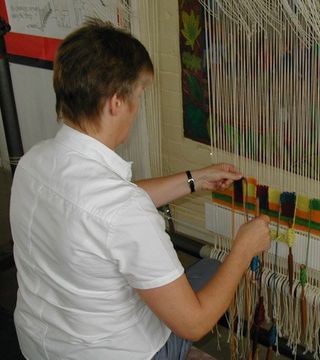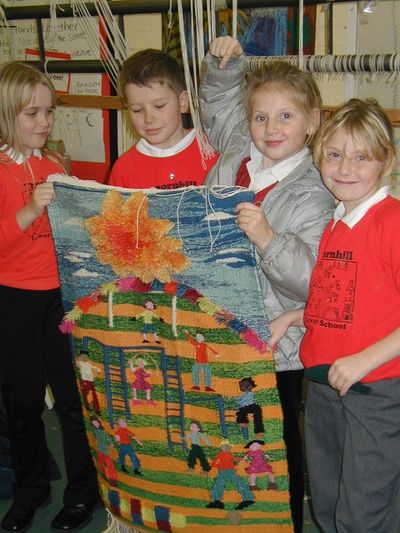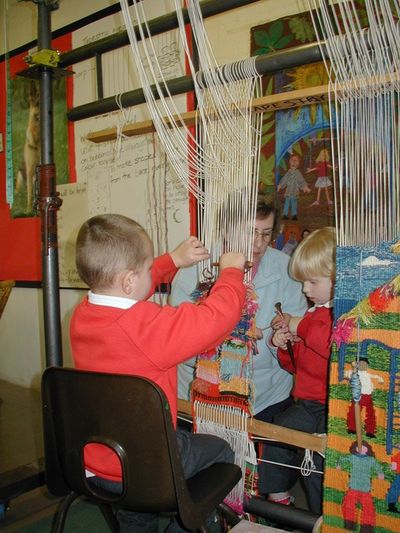Thornhill School
Tapestry Project

July - 2001
I worked with Thornhill School's after school club doing introductory exercises about weaving and colour theory. This developed into a wonderful tapestry designed and made by the whole school community.
I collected drawings from all years of the school to work on a design for the tapestry. Favourite subjects included playtime, school and home. I divided them into groups of drawings which showed morning school, middle of the day playtime and evening or home time.
I drew up the design in oil pastels, not precisely so that there is a freedom to change as it is woven. The character of weaving and qualities of yarn is also impossible to draw.
Each class in Thornhill School is named after a tree; this gave the idea for the border to be made of leaves appliquéd in dyed, recycled blanket fabric and stitched onto a blanket background. The dyes used for the blankets are the same as those used for yarns in weaving. This extends the size of the finished piece quicker than weaving a larger tapestry.
The completed tapestry is now in the school hall.
September 2001
I installed loom in the school, in a spare classroom set aside for parents to use, and held a Saturday workshop with adults. The day was good for the staff, providing chance for discussion and interaction in a relaxed situation. During the day we worked out that it is possible to do achieve almost the whole National Curriculum with a weaving project.
Maths - calculating yarn quantities for warp and weft and weave structures.
English - stories, poetry and songs about weaving.
Science - Chemistry, dyeing yarns. Physics, colour theory.
Art and History of Art - colour theory, design, textiles.
Design technology - installing and building weaving equipment (loom). Exploring the varieties and uses of fabric and weaving.
History - development of weaving from hand made to high technology.
Geography - textiles around the world, materials form different regions and climates.
During the term I worked in school two days a week, all classes had a chance to weave. I put two sample warps alongside the main tapestry for teaching on and for children to practice. This meant that they had enough confidence to create their own ideas; some of them learned to do carpet weaving and adapted the design. They made use of these when I was not there as well as weaving on the main piece. The planned flat woven image of flags was changed to a rainbow of tufted carpet weaving, and then they decided to weave the sun in the same way. This decision was made by the after school club children and was a really successful and lifted the whole design. The children learned how to finish the weaving, using the warp yarn to finish the edge strong and neat, they realised that this made it even more like a carpet and commented on the similarity to carpets in their own homes.
A longer term residency proved very successful with both children and adults becoming familiar with the process of designing and making a piece of art for public display. I encouraged all participants to be self critical and be prepared to undo and redo any mistakes.
Linking the colours used in dyeing yarns and blankets made the whole image come together very well. While the finished piece is very similar to the drawn image it has a very individual and special quality. I can identify parts of the weaving done by specific children.
December 2001.
The last week of the residency I worked in school on finishing stitching and backing, so that the children could see the whole process and understand the linked techniques. Towards the end of the residency they became a bit restless, and were not so motivated. This may have been because staff were very busy with Christmas activities and had limited time and energy. Some of the children lost interest when they had finished weaving while others seemed to enjoy the stitching more.
This project highlighted the different learning styles children have. One child who had experienced great difficulty in learning standard classroom curriculum showed quick understanding when given tasks linked to maintaining the loom and keeping a yarn store. He gained self esteem and respect from others.
The whole project took ten weeks to complete, approximately 30 days of my time. The success of weaving a large piece on the scaffolding loom with young children has encouraged me to do similar scale projects.
The end result was unveiled with great ceremony and the children are rightly proud of their work, staff have been amazed at the skills the children learned.





